Introduction: How One Beatles' Ballad Became a Cultural Standard On October 19, 1965, “Yesterday” by the Beatles was still reigning at No. 1 on the
Introduction: How One Beatles’ Ballad Became a Cultural Standard
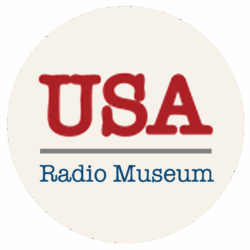 On October 19, 1965, “Yesterday” by the Beatles was still reigning at No. 1 on the Billboard Hot 100—a quiet ballad holding its own in a world of rock and revolution. Written by Paul McCartney and recorded solo with a string quartet, “Yesterday” marked a turning point not only for the Beatles, but for pop music itself.
On October 19, 1965, “Yesterday” by the Beatles was still reigning at No. 1 on the Billboard Hot 100—a quiet ballad holding its own in a world of rock and revolution. Written by Paul McCartney and recorded solo with a string quartet, “Yesterday” marked a turning point not only for the Beatles, but for pop music itself.
And this number was unprecedented. “Yesterday” was a first. The Beatles had never released a song featuring just one member.
In just over two minutes, it covered faded heartbreak, memory, and melodic grace into a timeless standard. Sixty years later, its echo remains unmatched. This tribute explores the song’s origin, its chart triumph, and the extraordinary legacy that made it the most covered song in music history. — USA RADIO MUSEUM
_____________________
From Dream to Number 1: The Birth of “Yesterday”
Paul McCartney didn’t write “Yesterday” in the studio, or on tour, or even with a guitar in hand. He dreamed it.
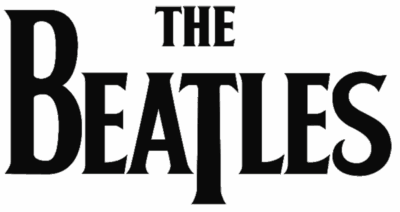 Sometime in early 1964, McCartney awoke in the attic bedroom of Jane Asher’s family home in London with a fully formed melody in his head. He rushed to the piano and played it through, astonished by its completeness. But he wasn’t sure if he’d composed it or simply remembered something already written. “I thought, ‘No, I’ve never heard this before,’” he later recalled. “But it was so complete, it sounded like someone else’s.”
Sometime in early 1964, McCartney awoke in the attic bedroom of Jane Asher’s family home in London with a fully formed melody in his head. He rushed to the piano and played it through, astonished by its completeness. But he wasn’t sure if he’d composed it or simply remembered something already written. “I thought, ‘No, I’ve never heard this before,’” he later recalled. “But it was so complete, it sounded like someone else’s.”
To test its originality, he gave it placeholder lyrics—“Scrambled eggs, oh my baby how I love your legs”—and played it for friends, colleagues, and music publishers. No one recognized it. It was his.
McCartney lived with the tune for months before writing the final lyrics. The process was slow, introspective, and deeply personal. “I didn’t want to wake up one morning and find that someone else had already written it,” he said. But once he was confident it was original, he shaped it into a ballad of regret and longing—universal themes that gave the song its emotional power.
The dreamlike quality of the melody remained. Its simplicity, its haunting progression, and its melancholic tone all reflected the subconscious clarity from which it was born. McCartney later described the experience as “magical,” a moment when the song seemed to arrive fully formed from somewhere beyond.
That dream became “Yesterday.” And on October 9, 1965, it reached No. 1 on the Billboard Hot 100. By October 19, it was still on top. From a quiet morning in a London attic to the summit of American radio, “Yesterday” had traveled from dream to dominance.
The Solo Beatle
On June 14, 1965, McCartney entered EMI Studios on Abbey Road—not with the Beatles, but alone. Between 7 and 10 p.m., he recorded “Yesterday” in two takes, accompanied only by his acoustic guitar. Take 2 became the master. A string quartet was later overdubbed on June 17, arranged by producer George Martin, marking the first time classical instrumentation was used so prominently on a Beatles track.
This was unprecedented. The Beatles had never released a song featuring just one member. “Yesterday” was a quiet rebellion—a break from the band’s rock roots and a glimpse into the introspective, genre-defying future they would soon embrace. It was chamber pop before the term existed, and it signaled McCartney’s emergence as a songwriter of emotional depth and melodic sophistication.
Charting the Moment: “Yesterday” Ascends
Though “Yesterday” appeared on the UK version of Help! in August 1965, it was never released as a single in Britain—a decision rooted in the Beatles’ evolving relationship with their home market and their desire to avoid overexposure. But in the United States, Capitol Records recognized its standalone power. On September 25, 1965, they issued it as a single, pairing it with “Act Naturally” as the B-side. The contrast was striking: one side featured Ringo Starr’s country-flavored charm, the other Paul McCartney’s solo ballad of aching introspection.
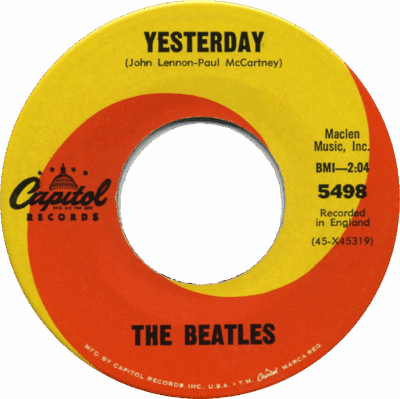 By October 9, when “Yesterday” had reached No. 1 on the Billboard Hot 100, the single would remain there for four consecutive weeks, including October 19, 1965—the date we honor today. It was the fifth of six consecutive No. 1 singles for the Beatles in the U.S., a record-setting streak that underscored their dominance of the American airwaves. The song stayed on the Billboard charts for 11 weeks overall, a testament to its enduring appeal and crossover power.
By October 9, when “Yesterday” had reached No. 1 on the Billboard Hot 100, the single would remain there for four consecutive weeks, including October 19, 1965—the date we honor today. It was the fifth of six consecutive No. 1 singles for the Beatles in the U.S., a record-setting streak that underscored their dominance of the American airwaves. The song stayed on the Billboard charts for 11 weeks overall, a testament to its enduring appeal and crossover power.
What made “Yesterday” so remarkable wasn’t just its chart position—it was how it got there. Unlike the Beatles’ previous hits, which leaned on electric guitars, harmonies, and rhythmic drive, “Yesterday” was starkly different. It featured only Paul McCartney’s voice and acoustic guitar, later enhanced by a string quartet arranged by George Martin. No drums. No backing vocals. No Lennon, Harrison, or Starr. It was the first Beatles track to spotlight a single member—and the first to embrace classical instrumentation so prominently.
Radio stations embraced it with surprising speed. Despite its departure from the Beatles’ usual sound, DJs across formats recognized its emotional power. On Top 40 stations, it played alongside rockers like “Ticket to Ride” and “Help!,” creating a sonic contrast that only heightened its impact. On easy listening and adult contemporary stations, it found a second life, appealing to older audiences who might have dismissed the Beatles as a teen phenomenon. Even classical and jazz programs gave it airtime, drawn to its harmonic richness and lyrical restraint.
The song’s brevity—just over two minutes—made it ideal for radio rotation. But its emotional depth gave it staying power. In an era dominated by British Invasion energy and American soul, “Yesterday” offered something rare: a moment of stillness. A breath of melancholy. A pause in the pop frenzy.
Its success also marked a turning point in the Beatles’ artistic evolution. “Yesterday” hinted at the introspective, genre-defying work to come—songs like “Eleanor Rigby,” “For No One,” and “Blackbird.” It showed that pop could be poetic, that simplicity could be profound, and that vulnerability could be revolutionary.
For Capitol Records, the single was a triumph. It validated their instinct to release it independently, and it reinforced the Beatles’ versatility. For McCartney, it was a personal milestone—the first Beatles song credited solely to him, and the first to showcase his melodic gift in such stark relief.
And for radio, “Yesterday” became a staple—played during dedications, memorials, and quiet hours. It bridged genres, generations, and emotions. More than a hit, it became a companion to memory itself—a soundtrack for reflection, nostalgia, and the tender yearnings and quiet reflections of our own yesterdays.
How “Yesterday” Became the Most Covered Song in Music History
When Paul McCartney recorded “Yesterday” solo in June 1965, it marked a quiet revolution. Backed only by his acoustic guitar and a string quartet arranged by George Martin, the song was unlike anything the Beatles had released before. It was intimate, melancholic, and deeply personal—just over two minutes of melodic vulnerability. No drums. No harmonies. No Lennon, Harrison, or Starr. It was the first Beatles track to feature a single member, and the first to embrace classical instrumentation so prominently.
![]() Released as a single in the U.S. in late-September 1965, “Yesterday” quickly captivated American audiences. Its success was immediate and enduring—not just as a chart-topper, but as a cultural shift. In a year dominated by electric guitars, British Invasion energy, and Motown rhythm, “Yesterday” offered something rare: a moment of stillness. A breath of melancholy. A pause in the pop frenzy.
Released as a single in the U.S. in late-September 1965, “Yesterday” quickly captivated American audiences. Its success was immediate and enduring—not just as a chart-topper, but as a cultural shift. In a year dominated by electric guitars, British Invasion energy, and Motown rhythm, “Yesterday” offered something rare: a moment of stillness. A breath of melancholy. A pause in the pop frenzy.
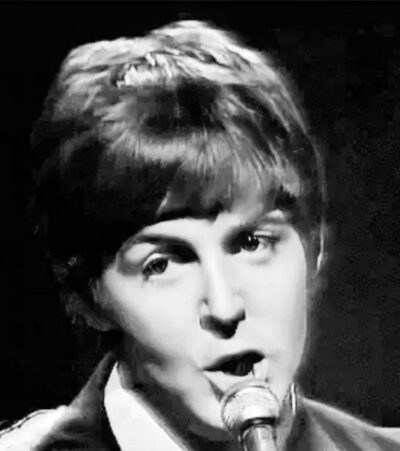
Paul McCartney performing ‘Yesterday’ live on-stage at Studio 50 on CBS-TV on the Ed Sullivan Show in NYC. The show was taped on August 14, 1965 and was aired on September 12.
What made “Yesterday” so universally resonant was its emotional clarity. The lyrics—simple yet profound—spoke to loss, regret, and the passage of time. The melody, dreamlike in origin, carried a timeless grace. McCartney had famously awakened with the tune in his head, unsure whether he’d composed it or remembered it. He called it “Scrambled Eggs” at first, testing its originality before shaping it into the ballad we know today. That subconscious genesis gave the song a purity that listeners felt immediately.
By the late 1960s, “Yesterday” was already being interpreted by artists across genres. Its minimalist structure—just voice, guitar, and strings—made it endlessly adaptable. Soul singers infused it with ache. Jazz artists explored its harmonic richness. Classical performers elevated it to concert hall grandeur. Folk musicians emphasized its lyrical intimacy. Pop crooners gave it polish. And international artists translated it into dozens of languages, proving its emotional resonance transcended borders.
According to Guinness World Records, “Yesterday” became the most covered song in recorded music history, with over 2,200 documented versions by the end of the 20th century. Among the most notable:
• Ray Charles turned it into a soulful lament, rich with gospel undertones. Ray Charles recorded “Yesterday” in 1967 for his album Ray Charles Invites You to Listen. His version is a masterclass in soul interpretation—slow, aching, and deeply personal. Charles’s phrasing stretches the melody into a blues lament, with subtle gospel undertones. His piano accompaniment is sparse and expressive, allowing the emotional weight of each lyric to land. It’s often cited as one of the most transformative covers of the song, turning McCartney’s ballad into a spiritual confession.
• Frank Sinatra gave it orchestral elegance, reframing it as a lounge standard. Sinatra’s rendition appeared on his 1969 album My Way, arranged with lush strings and a full orchestra. Though he reportedly found the lyrics “a bit teenage,” his performance gave “Yesterday” a mature, world-weary elegance. Sinatra’s smooth phrasing and controlled vibrato reframed the song as a lounge standard—ideal for late-night radio and reflective moments. His version helped introduce “Yesterday” to older audiences who may have overlooked the Beatles’ original.
• Aretha Franklin transformed it into a spiritual reflection with gospel crescendos. Aretha recorded “Yesterday” in 1979 for her album Sweet Passion. Her gospel-infused interpretation is rich with vocal improvisation and emotional crescendos. She transforms the song into a spiritual lament, drawing out its themes of loss and longing with soul-stirring intensity. Backed by piano and subtle strings, Aretha’s version is both reverent and revelatory—proof that “Yesterday” could live in the church as easily as on the charts.
• Boyz II Men added contemporary R&B harmonies, making it resonate with a new generation. In the 1990s, Boyz II Men brought “Yesterday” into the realm of contemporary R&B. Their a cappella version, often performed live, showcased their signature harmonies and emotional control. The group’s vocal layering added new texture and depth, making the song resonate with younger audiences while honoring its classic roots. Their rendition was featured in tribute specials and award shows, reinforcing “Yesterday” as a timeless standard across generations.
• Placido Domingo elevated it to operatic grandeur, proving its place in classical repertoire. Domingo’s operatic version of “Yesterday” appeared on crossover albums in the late ’80s and early ’90s. Sung with full orchestral backing, his interpretation brought classical grandeur to the melody. Domingo’s powerful tenor voice elevated the song into a dramatic aria, proving that “Yesterday” could thrive in concert halls as well as pop charts. His version is often used in international tributes and formal events, adding a layer of global reverence.
• Bob Dylan, though never releasing a studio version, quietly admired its lyrical economy and melodic strength. While Dylan never released a studio version of “Yesterday,” his admiration for the song is well documented. McCartney has recalled Dylan quietly acknowledging its brilliance, despite their stylistic differences. Dylan’s influence is felt more in the song’s lyrical economy—“Yesterday” shares the kind of poetic minimalism that Dylan himself mastered. His live performances and interviews often hinted at a deep respect for McCartney’s songwriting craft.
The song’s adaptability wasn’t just musical—it was emotional. “Yesterday” became a staple in radio dedications, memorials, and quiet hours. DJs used it to bridge genres, spinning it between rockers and crooners, soul and jazz. It was played at weddings and funerals, in films and commercials, in karaoke bars and concert halls.
By the end of the 20th century, “Yesterday” had transcended its origins. It was no longer just a Beatles song—it was a standard, like “Summertime” or “My Way.” It was taught in music schools, performed in recitals, and studied by songwriters seeking to understand its magic. And unlike many standards, it was written by a living artist. McCartney’s continued performances of “Yesterday” throughout his solo career helped reinforce its legacy, reminding audiences that timelessness can be born in a single moment of inspiration.
“Yesterday” didn’t just top charts—it became a companion to memory itself. A melody for longing. A mirror for emotion. A song for all time.
Radio’s Role in the Cover Boom
Radio stations played a pivotal role in popularizing the countless reinterpretations of “Yesterday.” In the late ’60s and throughout the ’70s, easy listening and adult contemporary formats became fertile ground for the song’s evolution. Its melodic simplicity and emotional clarity made it a natural fit for stations seeking to soothe, reflect, and connect.
DJs often used “Yesterday” as a bridge between genres—spinning Frank Sinatra’s orchestral version after the Beatles’ original, or Ray Charles’s soulful lament following Ella Fitzgerald’s jazz-inflected take. These transitions weren’t just musical—they were emotional handoffs, guiding listeners through moods and memories with grace.
Tribute shows, anniversary specials, and themed programming kept the song in steady rotation. Whether marking the passing of a public figure, celebrating a Beatles milestone, or simply curating a “Songs That Endure” segment, “Yesterday” was a go-to choice. Its adaptability made it a favorite for dedications, memorials, and quiet hours—moments when radio became not just entertainment, but companionship.
Even regional stations embraced local covers, spotlighting artists who reimagined the song in gospel, folk, or bilingual formats. In doing so, radio helped “Yesterday” transcend its origins, turning it from a Beatles ballad into a shared cultural standard. It wasn’t just played—it was felt.
McCartney’s Masterstroke: The Song That Changed Everything
“Yesterday” wasn’t just a turning point for the Beatles—it was a turning point for Paul McCartney as a songwriter, a performer, and an artist willing to embrace vulnerability. Though officially credited to Lennon–McCartney, it was the first Beatles song written and recorded solely by Paul. No harmonies. No band. Just voice, guitar, and strings. It was a bold departure from the group’s signature sound—and a quiet declaration of McCartney’s melodic genius.
The song’s creation was as mysterious as its impact. McCartney famously dreamed the melody in early 1964, waking in the attic bedroom of Jane Asher’s family home with the tune fully formed in his mind. He played it on the piano, unsure whether he’d composed it or remembered it. “It was like I’d been given it,” he later said. “It was a magical thing.” That sense of gift—of something arriving whole from beyond—infused the song with a purity that listeners felt immediately.
When it came time to record “Yesterday” on June 14, 1965, McCartney entered EMI Studios alone. The Beatles had never recorded a track featuring just one member, and the idea of adding a string quartet was unprecedented in their catalog. Producer George Martin, ever the visionary, arranged the quartet with restraint and elegance—two violins, a viola, and a cello. His goal was to enhance, not overwhelm. “I didn’t want it to sound syrupy,” Martin recalled. “It had to be tasteful.”
The result was a masterclass in minimalism. McCartney’s vocal is tender but controlled, his guitar playing simple yet expressive. The strings add emotional depth without sentimentality, weaving around the melody like memory itself. In just over two minutes, “Yesterday” achieves what few songs ever do: it creates space for reflection, for longing, for the quiet ache of time passed.
Historically, Capitol Records recognized its power immediately. In a decisive move, they released “Yesterday” as a standalone single in the United States on September 25, 1965, backed with “Act Naturally.” This was a bold contrast to the UK, where EMI chose not to issue the song as a 45 rpm single, keeping it exclusively on the Help! LP. The British strategy reflected a more conservative approach to Beatles releases, while Capitol’s decision proved visionary—embracing the song’s crossover appeal and emotional resonance.
The single soared. It became the fifth of six consecutive chart-toppers for the Beatles in the U.S.—a record at the time. But more than a hit, it was a cultural shift. “Yesterday” proved that pop music could be introspective, that a single voice could carry emotional weight, and that vulnerability could be revolutionary.
For McCartney, “Yesterday” was a door opening—to solo work, to orchestral experimentation, to deeper lyrical themes. It foreshadowed songs like “Eleanor Rigby,” “Blackbird,” and “Let It Be.” It showed that melody could be timeless, and that sometimes, the quietest songs speak the loudest.
Conclusion: Yesterday, Today, and Always
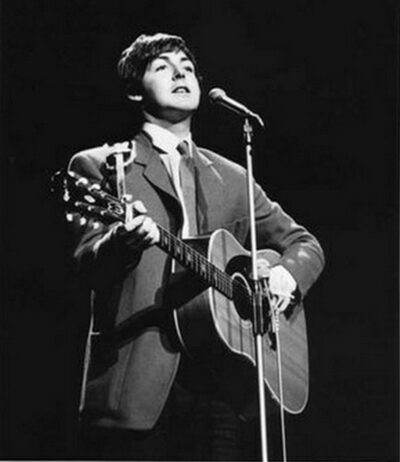
Paul McCartney sings “Yesterday” during CBS taping of the Ed Sullivan Show, the day before their NYC Shea concert, August 14 1965.
By the end of the 20th century, “Yesterday” had become more than a Beatles song—it was a standard, like “Summertime” or “My Way.” It was taught in music schools, performed in recitals, and used in film, television, and advertising. Its emotional resonance made it a go-to for artists seeking to connect deeply with audiences.
And unlike many standards, it was written by a living artist. McCartney’s continued performances of “Yesterday” throughout his solo career helped reinforce its legacy, reminding audiences that timelessness can be born in a single moment of inspiration.
“Yesterday” is more than a song—it’s a memory set to music, a universal ache wrapped in melody. From its dreamlike inception to its historic chart run and thousands of reinterpretations, it has become a touchstone for artists and listeners alike. It reminds us that vulnerability can be powerful, that simplicity can be profound, and that music—at its best—can transcend time.
As we honor its legacy at the USA Radio Museum, we celebrate not just a Beatles milestone, but a moment of emotional truth that continues to resonate across generations. “Yesterday” lives on—not in the past, but in every heart it touches, for it is McCartney’s own living standard—a ballad of memory, longing, and timeless grace.
_____________________
Contact: jimf.usaradiomuseum@gmail.com
_____________________
A USARM Viewing Tip: On your PC? Mouse/click over each image for expanded views. On your mobile or tablet device? Finger-tap all the above images inside the post and stretch image across your device’s screen for LARGEST digitized view. Then click your brower’s back arrow to return to the featured post.
© 2025 USA Radio Museum. All rights reserved.

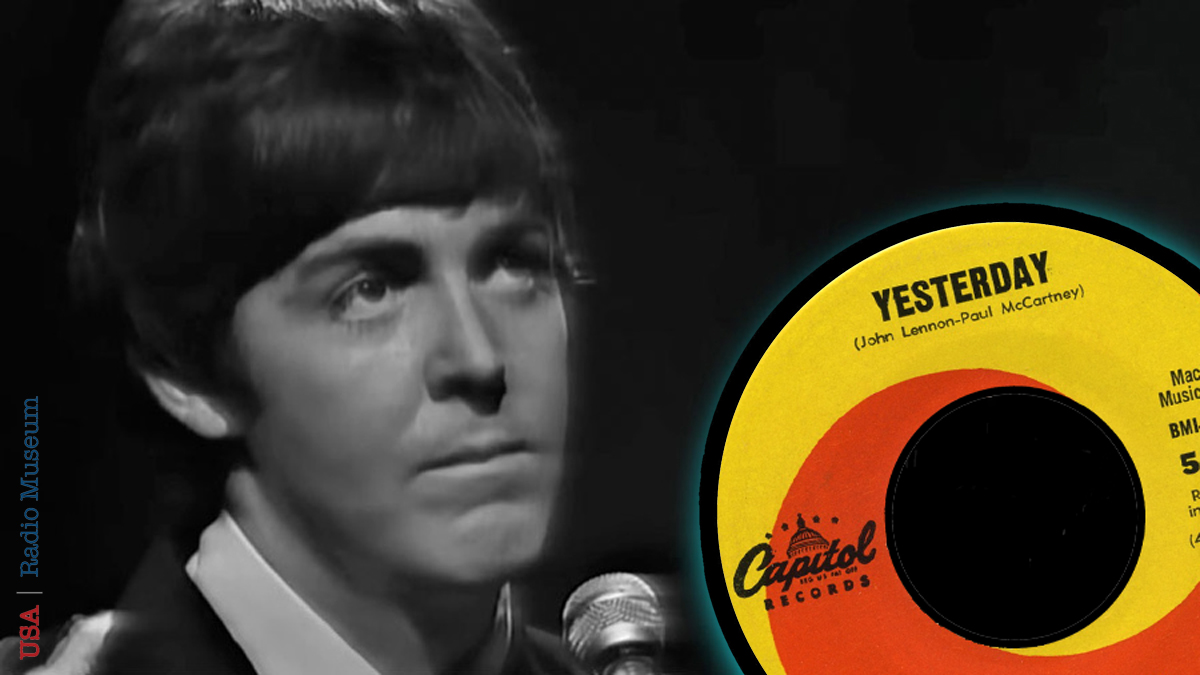
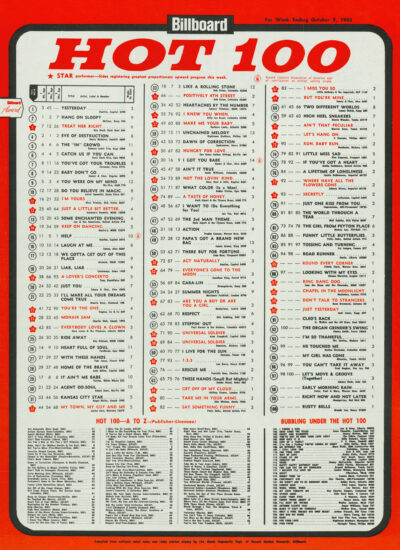


Uh Jim you forgot one Girl Group that did a cover of “Yesterday”, En Vogue for they were the 1st R&B Girl Group that did a remake of this iconic classic in the early ’90’s.
Vaughn, thank you for that . . . duly noted!
My pleasure. 😉